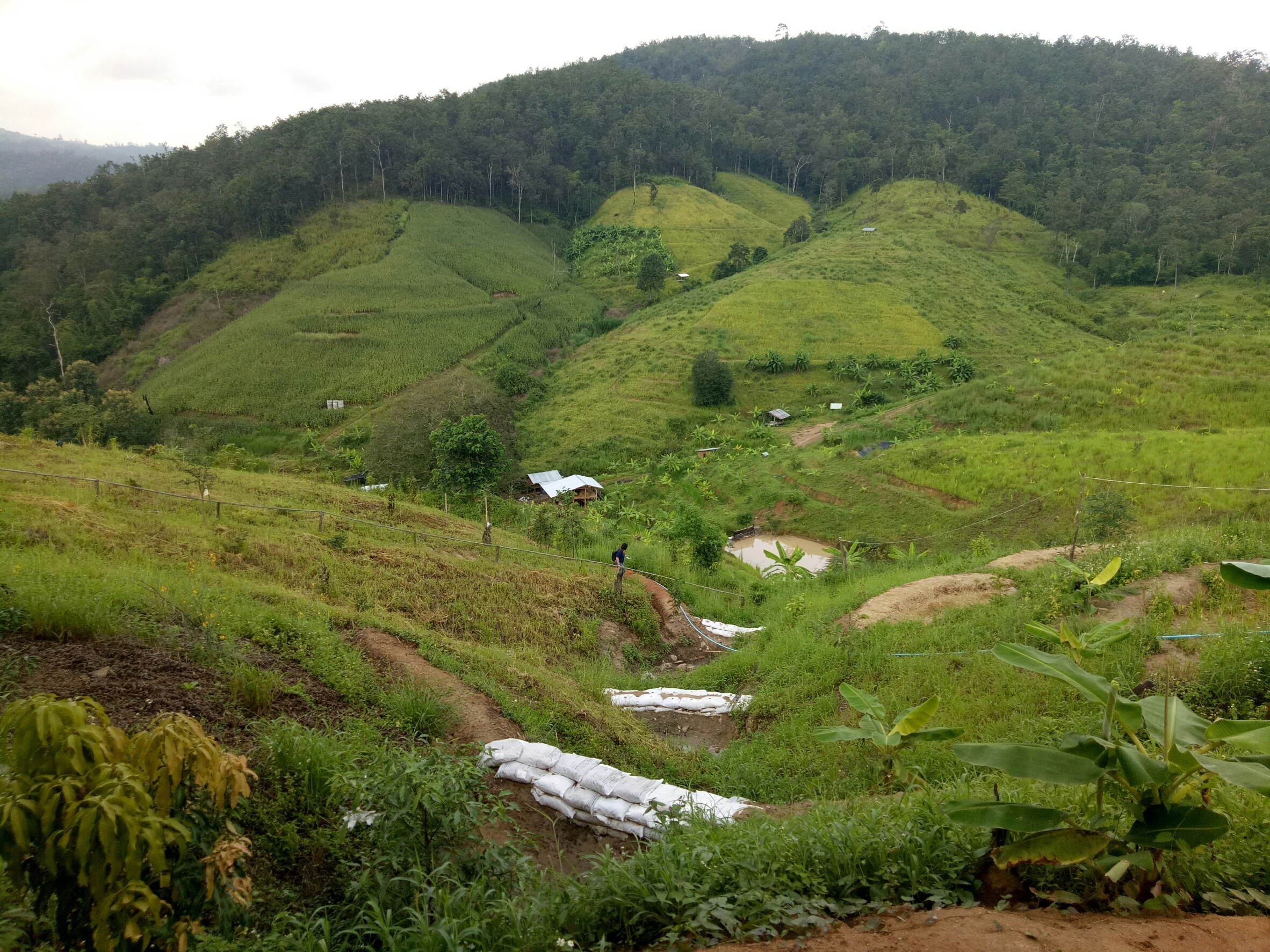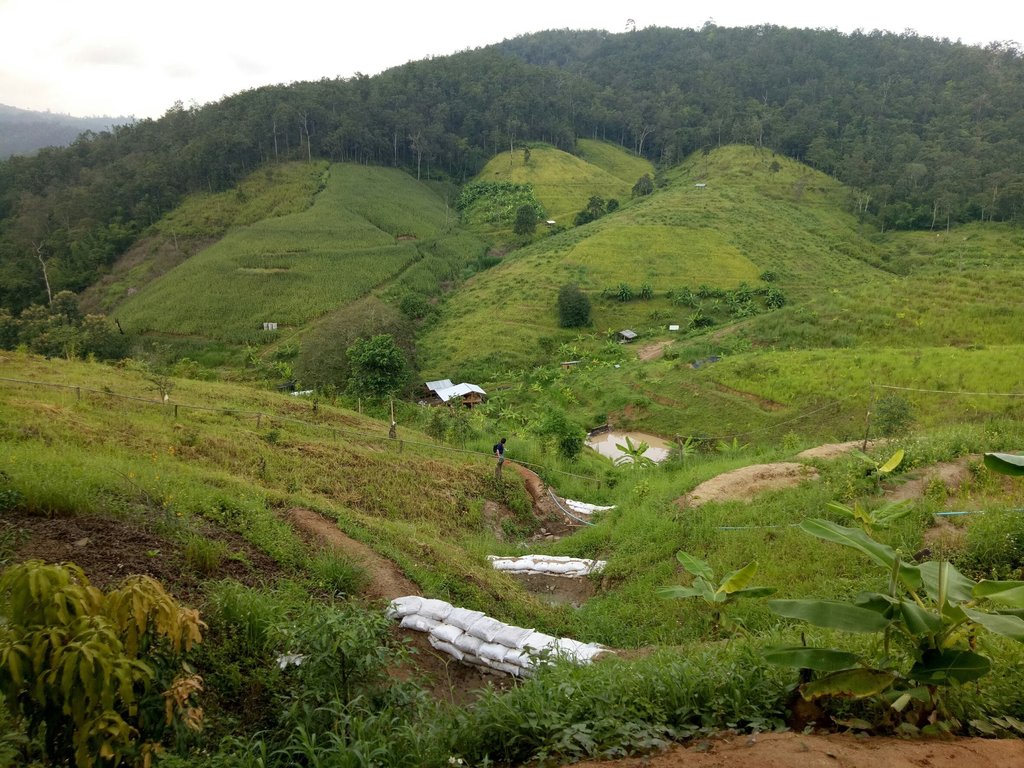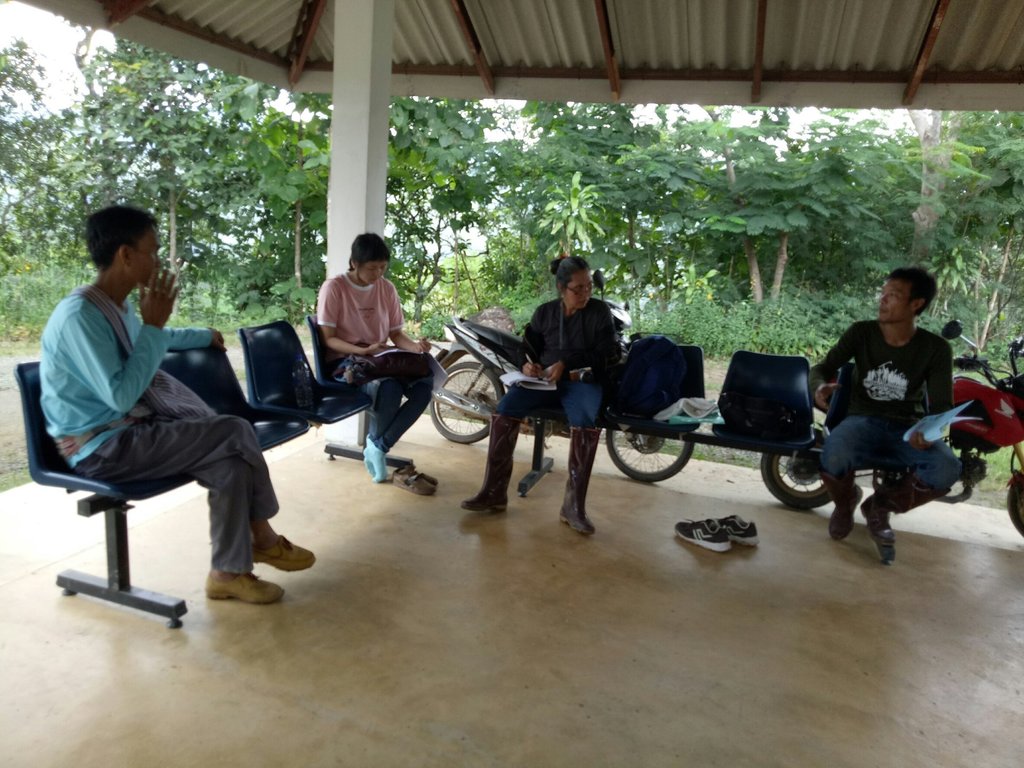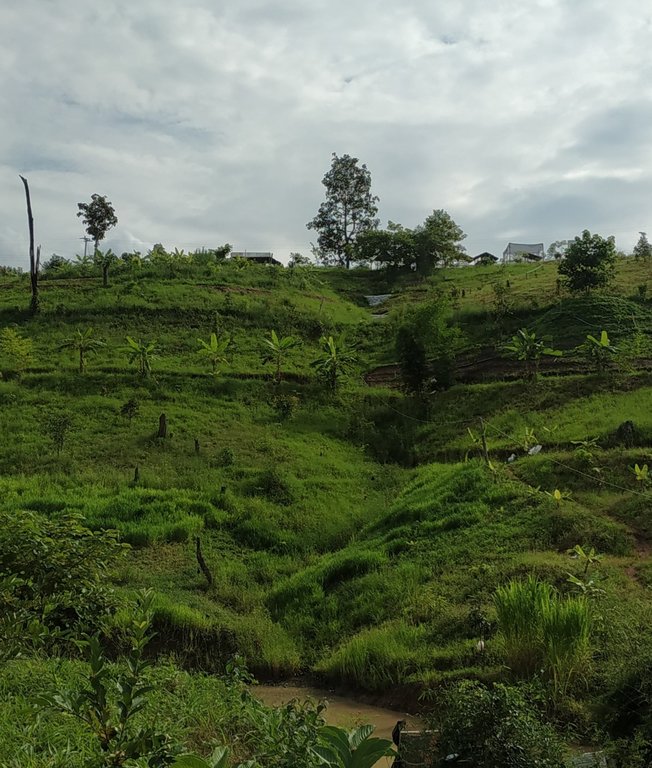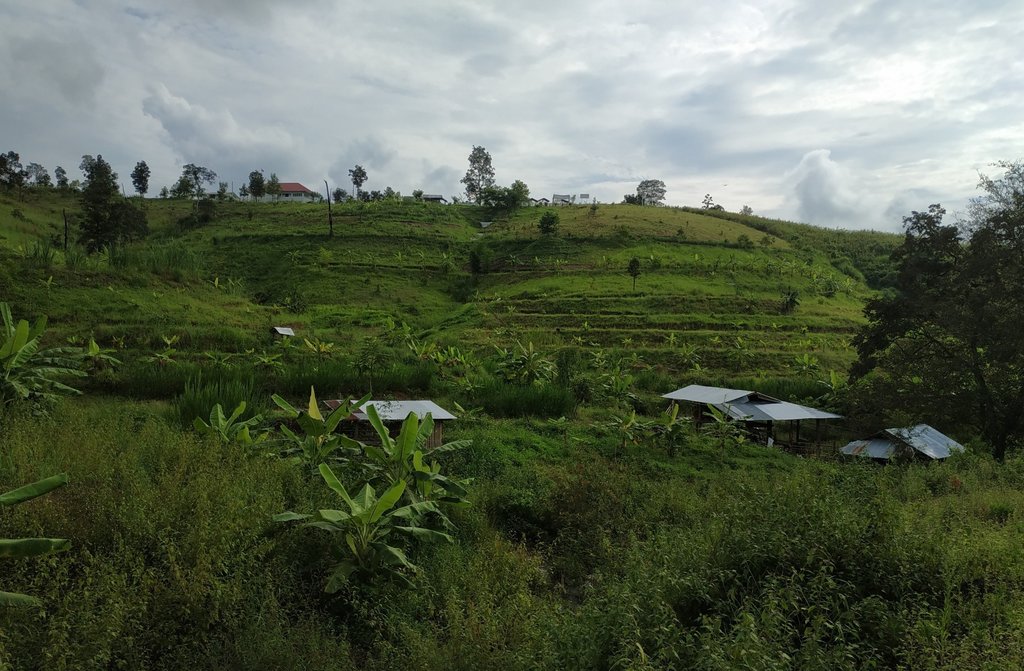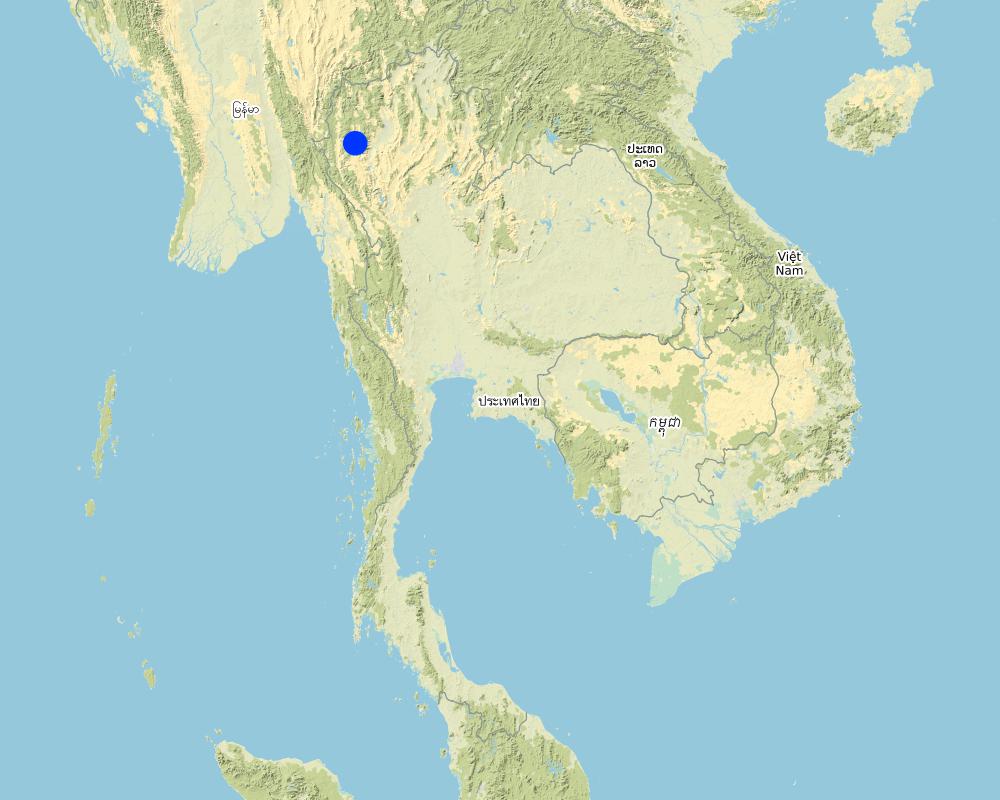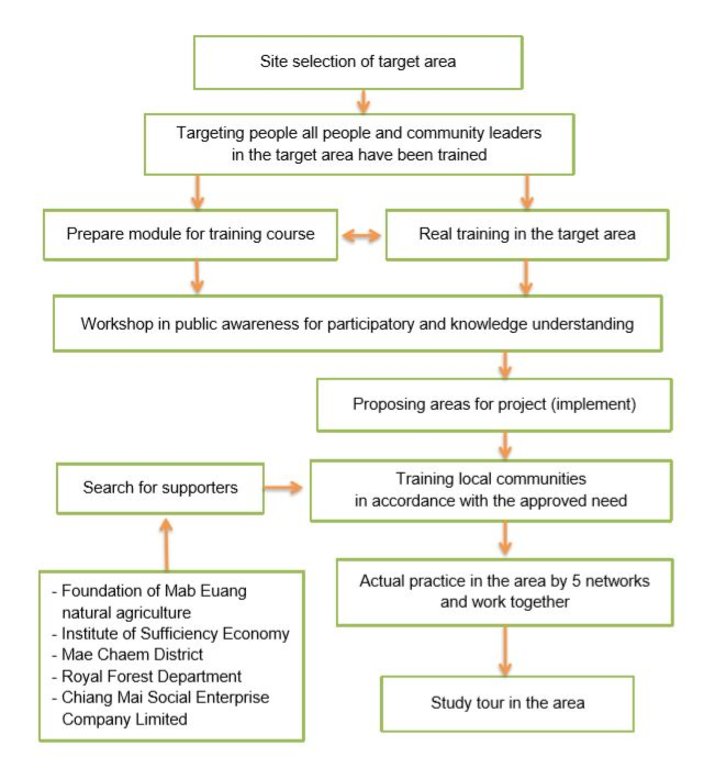Returning Life to Mae Chaem Watershed by Integrated Land and Water Management [ໄທ]
- ການສ້າງ:
- ປັບປູງ:
- ຜູ້ສັງລວມຂໍ້ມູນ: Pitayakon Limtong
- ບັນນາທິການ: –
- ຜູ້ທົບທວນຄືນ: Rima Mekdaschi Studer, William Critchley
Integrated land and water management in landscape of Khok-Nong-Na model
approaches_4280 - ໄທ
ເບິ່ງພາກສ່ວນ
ຂະຫຍາຍທັງໝົດ ຍຸບທັງໝົດ1. ຂໍ້ມູນທົ່ວໄປ
1.2 ລາຍລະອຽດ ການຕິດຕໍ່ ຂອງບຸກຄົນທີ່ຊັບພະຍາກອນ ແລະ ສະຖາບັນ ການມີສ່ວນຮ່ວມ ໃນການປະເມີນຜົນ ແລະ ເອກະສານ ຂອງວິທີທາງ
co-compiler:
co-compiler:
1.3 ເງື່ອນໄຂ ຂອງການນໍາໃຊ້ເອກກະສານຂໍ້ມູນ ຂອງ WOCAT
ເມື່ອໃດທີ່ໄດ້ສັງລວມຂໍ້ມູນ (ຢູ່ພາກສະໜາມ)?
12/09/2018
ຜູ້ສັງລວມ ແລະ ບັນດາຜູ້ຕອບແບບສອບຖາມ ຍອມຮັບໃນເງື່ອນໄຂ ການນໍາໃຊ້ຂໍ້ມູນເອກະສານ ທີ່ສ້າງຂື້ນ ໂດຍຜ່ານ ອົງການ WOCAT:
ແມ່ນ
2. ພັນລະນາ ແນວທາງການຄຸ້ມຄອງນໍາໃຊ້ດິນແບບຍືນຍົງ
2.1 ການອະທິບາຍ ໂດຍຫຍໍ້ ຂອງວິທີທາງ
The promotion of a model that supports sustainable cultivation outside the protected forest area in the northern highlands of Thailand. The model is based on the knowledge of King Bhumibol Adulyadej (King Rama 9). It is a prototype model of the Institute of Sufficiency Economy and the Foundation for Natural Agriculture, and uses the New Theory Approach in Agriculture to build a self-sufficiency economy.
2.2 ການອະທິບາຍ ລາຍລະອຽດ ຂອງວິທີທາງ
ການອະທິບາຍ ລາຍລະອຽດ ຂອງວິທີທາງ:
This is the approach that supports "returning life" to the Mae Chaem area by an integrated land and water management system in the highlands, through the King Rama 9 initiative combined with local wisdom: or the "Khok-Nong-Na model". Most of this area is in Mae Chaem Reserved National Forest, an upstream watershed which is strictly preserved as forest and does not officially allow people to live and cultivate. However, communities have been earning their living there for a long time before the reserved forest law was announced, which deprived them of the right to own the land and use it for agriculture. Previously all land users earned income by encroaching into Mae Chaem National Forest Reserve - and converting it into maize, shallot and cabbage fields. The forest area was intruded upon, making the soil erode, and therefore soil fertility and productivity decreased. The integrated water management system by King Rama 9’s initiative together with local wisdom, is a prototype model at the Sufficiency Economy Institute and the Natural Agriculture Foundation, supporting the “New Theory of Agriculture” based on a self-sufficiency economy. The Foundation has explained to all land users that this concept called "Khok-Nong-Na" divides the area into 30:30:30:10 portions as follows; 30% for water sources (farm ponds, small water channels), 30% for rice fields, 30% for trees, and 10% for housing and animals. Implementation of Khok-Nong-Na models will depend on the topography of the area are as follow:
1. Upland or "mound" (Khok) is the highland area as part of the mountain or hill to cultivate "three kinds of trees” as forests, namely "three forests, four benefits". “Three kinds of forests” means for consumption, construction and economy, while the fourth benefit is to preserve the ecosystem.
2. Reservoir (Nong), the lowland area as part of water resources, includes the checkdam or weir, the sediment trap, the water channel and the pond, for both consumption and agricultural use. The checkdam or weir in the upper area serves as a storage and to control the flow rate of water. The water channel is designed to deliver water to the pond or reservoir in the lower area.
3. Paddy field (Na) is an important component for rice cultivation because rice is the main staple. Rice terraces are established in the sloping area, with paddy fields in the lowland. The main purpose of rice production is for the farmer family’s consumption - as well as for income. The ridges around the rice terraces field should be high and wide to store greater amounts of water - as the water level in the paddy field can control weeds, accelerate plant growth and improve crop yields. The native rice variety grown in rich soil is immune to diseases and insects.
2.3 ຮູບພາບຂອງແນວທາງ
2.4 ວີດີໂອ ຂອງວິທີທາງ
ວັນທີ:
12/09/2018
2.5 ປະເທດ / ເຂດ / ສະຖານທີ່ບ່ອນທີ່ແນວທາງໄດ້ຖືກນໍາໃຊ້
ປະເທດ:
ໄທ
ພາກພື້ນ / ລັດ / ແຂວງ:
Ban Thap Sub-district, Mae Chaem District, Chiang Mai Province
ຂໍ້ມູນເພີ່ມເຕີມຂອງສະຖານທີ່:
Ban Thap Sub-district, Mae Chaem District
Map
×2.6 ວັນທີເລີ່ມຕົ້ນ ແລະ ສິ້ນສຸດ ການຈັດຕັ້ງປະຕີບັດ ວິທີທາງ
ສະແດງປີຂອງການເລີ່ມຕົ້ນ:
2015
ຖ້າຫາກບໍ່ຮູ້ຈັກປີທີ່ແນ່ນອນ, ໃຫ້ປະມານຄາດຄະເນ ເອົາມື້ທີ່ໄດ້ເລີ່ມຈັດຕັ້ງປະຕິບັດ ວິທີທາງ:
ຕໍ່າກວ່າ 10 ປີ ຜ່ານມາ (ມາເຖິງປະຈຸບັນ)
ຄວາມຄິດເຫັນ:
Almost land users faced problem about debt from the investment loan for their agricultural and other activities.
2.7 ປະເພດຂອງແນວທາງ
- ພາຍໃຕ້ໂຄງການ / ແຜນງານ
2.8 ເປົ້າໝາຍ / ຈຸດປະສົງຫຼັກ ຂອງການຈັດຕັ້ງປະຕິບັດ ວິທີທາງ
The integrated land management of Khok-Nong-Na model "returns life to the watershed" by protecting the ecosystem and simultaneously promoting sustainable and productive farming.
2.9 ເງື່ອນໄຂອໍານວຍ ຫຼື ຂັດຂວາງການປະຕິບັດຂອງເຕັກໂນໂລຢີ / ເຕັກໂນໂລຢີການນໍາໃຊ້ຕາມແນວທາງ
ມີຄວາມສາມາດ / ເຂັ້າເຖິງຊັບພະຍາກອນດ້ານການເງິນ ແລະ ການບໍລິການ
- ເຊື່ອງຊ້ອນ
They should stop borrowing money as they cannot find money to clear their debts.
ການຮ່ວມມື / ການປະສານງານຂອງຜູ້ກ່ຽວຂ້ອງ
- ອໍານວຍ
Almost all land users help each other and collaborate to work together around twice a week.
ວຽກ, ມີກໍາລັງຄົນ
- ເຊື່ອງຊ້ອນ
They have more workload in their field to do comfortably in one day and there are no labourers to hire in this area.
3. ການມີສ່ວນຮ່ວມ ແລະ ບົດບາດຂອງພາກສ່ວນທີ່ກ່ຽວຂ້ອງທີ່ໄດ້ມີສ່ວນຮ່ວມ
3.1 ຜູ້ມີສ່ວນຮ່ວມ ໃນວິທີທາງ ແລະ ພາລະບົດບາດ ຂອງເຂົາເຈົ້າ
- ຜູ້ນໍາໃຊ້ດິນໃນທ້ອງຖິ່ນ / ຊຸມຊົນທ້ອງຖິ່ນ
Household network covers 21 members
All land users cooperate with each others
- ອົງການຈັດຕັ້ງ ທີ່ບໍ່ຂື້ນກັບລັດຖະບານ
Natural Agriculture Study Center
Support all knowledge in the New Theory for Agriculture (King Rama 9)
- ພາກເອກະຊົນ
Chiang Mai Social Enterprise Company Limited
Support seed of some crops and saplings of trees and fruit trees
- ອໍານາດ ການປົກຄອງທ້ອງຖິ່ນ
Royal Forest Department and Mae Chaem District Administrative Organization
Create a project to manage to obtain multiple benefits from the forest for sustainable development by King Rama 9.
3.2 ການມີສ່ວນຮ່ວມຂອງຜູ້ນໍາໃຊ້ທີ່ດິນໃນທ້ອງຖິ່ນ / ຊຸມຊົນທ້ອງຖິ່ນໃນໄລຍະທີ່ແຕກຕ່າງກັນຂອງແນວທາງ
| ການລວບລວມ ເອົາຜູ້ນໍາໃຊ້ດິນ ໃນທ້ອງຖິ່ນ / ຊຸມຊົນທ້ອງຖິ່ນ | ໃຫ້ລະບຸ ຜູ້ໃດທີ່ມີສ່ວນຮ່ວມ ໃນແຕ່ລະກິດຈະກໍາ? | |
|---|---|---|
| ການເລີ່ມຕົ້ນ / ແຮງຈູງໃຈ | ການຊ່ວຍເຫຼືອຈາກພາຍນອກ | All land users normally face drought condition, making them unable to produce agricultural products properly, causing insufficient income and the debts of land users accumulate. |
| ການວາງແຜນ | ການຮ່ວມມື | Mae Chaem District Office set up a project to return life to all land users, so they can join and work together. |
| ການປະຕິບັດ | ການຮ່ວມມື | Land users work together with several networks in Khok-Nong-Na model with support from the Royal Forest Department, Natural Agriculture Study Center, Mae Chaem District Office and Chiang Mai Social Enterprise Company Limited. |
| ຕິດຕາມກວດກາ / ການປະເມີນຜົນ | ການນໍາໃໍຊ້ເອງ | Monitor, evaluate and follow up by Deputy Minister of Agriculture and Cooperatives and Natural Agriculture Study Center with local officers in the area. |
3.3 ແຜນວາດ (ຖ້າມີ)
ການອະທິບາຍ:
Flow chart Operating procedures:
1. Site selection: the target area will be seen through 5 aspects: community, temple, school, government agency and appropriate topography, with 5 strong network sectors as: government, academic, private, civil social and mass media for sustainability and expansion of civil state
2. Targeting people: all people and community leaders in the target area have been trained at the Mab-Euang Natural Agriculture Foundation.
3. Training course: the main content is agricultural development to the sufficiency economy system by the Natural Agriculture Network. This is to take 5 days and 4 nights, consisting of application of New Theory of Agriculture in the concept of sufficiency economy combined with local wisdom for soil and water management for agricultural area.
4. Workshop: this activity is organized for farmers to learn about participation, extension and to understand the concept of sufficiency economy system.
5. Joint activity: people and communities in the area propose to implement this project and staff of the study center will consider and, when appropriate, approve the project.
6. Finding support agencies: the Mab-Euang Natural Agriculture Center for Sufficiency Economy System, Mae Chaem District Office, Royal Forest Department and Chiang Mai Enterprise Social Enterprise Company Limited.
7. Field training: this activity is the real field training in the selected area, where land users and community members have been trained according to the concept of Khok-Nong-Na model.
8. Area improvement: the practices in the targeted area consist of 5 networks that work together in the land user’s area in the concept of Khok-Nong-Na model with trees and fruit trees in upland and rice cultivation in lowland or rice terraces in upland, including farm ponds. Moreover, this area will be the training and study site for other people in this area.
9. Study center: if this area is completely set up and all components of the Khok-Nong-Na model are installed, the site should be upgraded to be a study center in the future. Now this project has increased cooperation among agencies, i.e. Royal Irrigation Department, Land Development Department, both under the Ministry of Agriculture and Cooperatives, Ministry of Natural Resources and Environment, and Department of Local Administration, Ministry of the Interior.
ຜູ້ຂຽນ:
Ms. Somjit Lertdisayawan
3.4 ການຕັດສິນໃຈກ່ຽວກັບການຄັດເລືອກເຕັກໂນໂລຢີຂອງການຄຸ້ມຄອງທີ່ດິນແບບຍືນຍົງ / ເຕັກໂນໂລຢີ
ລະບຸ ຄົນທີ່ຕັດສິນໃຈ ກ່ຽວກັບການຄັດເລືອກຂອງ ເຕັກໂນໂລຢີ / ເຕັກໂນໂລຢີ ຈະໄດ້ຮັບການປະຕິບັດ:
- ຜູ້ນໍາໃຊ້ທີ່ດິນຫຼັກ, ການສະໜັບສະໜູນ ໂດຍຜູ້ຊ່ຽວຊານ ການນໍາໃຊ້ທີ່ດິນແບບຍືນຍົງ
ອະທິບາຍ:
All land users had been trained by several agencies, and let they decide the suitable technology to their area.
Specify on what basis decisions were made:
- ປະເມີນເອກກະສານ ຄວາມຮູ້ກ່ຽວກັບ ການຄຸ້ມຄອງ ທີ່ດິນແບບຍືນຍົງ (ຫຼັກຖານທີ່ຊ່ວຍໃນການຕັດສິນໃຈ)
4. ການສະໜັບສະໜູນທາງດ້ານວິຊາການ, ການສ້າງຄວາມສາມາດ, ແລະ ການຈັດການຄວາມຮູ້.
4.1 ການສ້າງຄວາມສາມາດ / ການຝຶກອົບຮົມ
ຜູ້ນໍາໃຊ້ທີ່ດິນ ຫຼື ພາກສ່ວນກ່ຽວຂ້ອງອື່ນໆ ໄດ້ຮັບການຝຶກອົບຮົມບໍ່?
ແມ່ນ
ໃຫ້ລະບຸ ຜູ້ໃດທີ່ໄດ້ຮັບການຝຶກອົບຮົມ:
- ຜູ້ນໍາໃຊ້ດິນ
ຖ້າເປັນໄປໄດ້, ໃຫ້ລະບຸເພດ, ອາຍຸ, ສະຖານະພາບ, ຊົນເຜົ່າ, ແລະ ອື່ນໆ:
-
ຮູບແບບຂອງການຝຶກອົບຮົມ:
- ຕົວຕໍ່ຕົວ
- ເນື້ອທີ່ສວນທົດລອງ
- ຫຼັກສູດ
ໃນຫົວຂໍ້:
Agricultural development to achieve a self-sufficiency economy system.
ຄວາມຄິດເຫັນ:
Training course 5 days and 4 nights before accepting to join the project.
4.2 ການບໍລິການໃຫ້ຄໍາປຶກສາ
ເຮັດຜູ້ໃຊ້ທີ່ດິນມີການເຂົ້າເຖິງການບໍລິການໃຫ້ຄໍາປຶກສາ?
ແມ່ນ
ລະບຸວ່າການສະໜອງ ການບໍລິການ ໃຫ້ຄໍາປຶກສາ:
- ໃນພື້ນທີ່ຂອງຜູ້ນໍາໃຊ້ດິນ
ອະທິບາຍ / ຄວາມຄິດເຫັນ:
Monitor, evaluate and follow up in the area.
4.3 ສະຖາບັນການສ້າງຄວາມເຂັ້ມແຂງ (ການພັດທະນາອົງການຈັດຕັ້ງ)
ສະຖາບັນ ໄດ້ຮັບການສ້າງຕັ້ງຂື້ນ ຫຼື ໄດ້ຮັບການສ້າງຄວາມເຂັ້ມແຂງ ໂດຍການຈັດຕັ້ງປະຕິບັດ ວິທີທາງບໍ່?
- ມີ, ພໍສົມຄວນ
ລະບຸ ທາງສະຖາບັນ ໄດ້ສ້າງຄວາມເຂັ້ມແຂງ ໃນລະດັບໃດ (ຫຼາຍ):
- ທ້ອງຖິ່ນ
ອະທິບາຍ ສະຖາບັນການຈັດຕັ້ງ, ພາລະບົດບາດ ແລະ ໜ້າທີ່ຮັບຜິດຊອບ, ສະມາຊິກ ແລະ ອື່ນໆ.
At present there are 21 household members in the group. There are rules and guidelines that indicate they must hold meetings and work together twice a week.
ລະບຸ ປະເພດ ຂອງສະໜັບສະໜູນ:
- ອຸປະກອນ
ໃຫ້ລາຍລະອຽດເພີ່ມເຕີມ:
Tools to work in the area as spade, shovel, ploughs and also saplings of trees and fruit trees, and the costs for travelling, fuel and food when they work together.
4.4 ຕິດຕາມກວດກາ ແລະ ປະເມີນຜົນ
ການຈັດຕັ້ງປະຕິບັດ ວິທີທາງ ໄດ້ມີການປະເມີນຜົນ ແລະ ຕິດຕາມບໍ?
ແມ່ນ
ຄວາມຄິດເຫັນ:
Monitor, evaluate and follow up by Natural Agriculture Study Center and also local officers.
ຖ້າແມ່ນ, ເອກກະສານສະບັບນີ້ ແມ່ນໄດ້ນໍາໃຊ້ເຂົ້າໃນການຕິດຕາມ ແລະ ປະເມີນຜົນບໍ່?
ບໍ່ແມ່ນ
ຄວາມຄິດເຫັນ:
-
4.5 ການຄົ້ນຄວ້າ
ນີ້້ແມ່ນສ່ວນໜຶ່ງ ການຄົ້ນຄວ້າ ຂອງວິທີທາງບໍ່?
ບໍ່ແມ່ນ
5. ການສະໜັບສະໜູນທາງດ້ານການເງິນ ແລະ ອຸປະກອນຈາກພາຍນອກ
5.1 ງົບປະມານປະຈໍາປີ ສໍາລັບວິທີທາງ ຂອງການຄຸ້ມຄອງ ທີ່ດິນແບບຍືນຍົງ
ຖ້າຫາກບໍ່ຮູ້ຈັດງົບປະມານທີ່ແນ່ນອນ ແມ່ນໃຫ້ປະມານເອົາ:
- > 1,000,000
5.2 ການສະໜັບສະໜູນ ທາງດ້ານການເງິນ / ອຸປະກອນ ສະໜອງໃຫ້ແກ່ຜູ້ນໍາທີ່ດິນ
ຜູ້ນໍາໃຊ້ດິນ ໄດ້ຮັບການສະໜັບສະໜູນ ທາງດ້ານ ການເງິນ / ອຸປະກອນ ໃນການຈັດຕັ້ງປະຕິບັດ ເຕັກໂນໂລຢີບໍ?
ແມ່ນ
ຖ້າແມ່ນ, ໃຫ້ລະບຸປະເພດ (ຫຼາຍ) ຂອງການສະໜັບສະໜູນ, ເງື່ອນໄຂ ແລະ ຜູູ້ສະໜອງ (ຫຼາຍ):
Agricultural equipment for land users to set up Khok-Nong-Na model such as spade, shovel, plough and also saplings of soil, trees and fruit trees by the Deputy Minister of Agriculture and Cooperatives, and Natural Agriculture Study Center.
5.3 ເງິນສົມທົບສໍາລັບການນໍາໃຊ້ສະເພາະປັດໃຈຂາເຂົ້າໃນການຜະລີດກະສິກໍາ (ລວມທັງແຮງງານ)
- ອຸປະກອນ
| ໃຫ້ລະບຸໄດ້ຮັບການສະໜັບສະໜູນປັດໃຈຂາເຂົ້າຫຍັງແດ່ | ທີ່ຂອບເຂດ | ລະບຸ ການອຸດໜູນ |
|---|---|---|
| ເຄື່ອງມື | ງົບປະມານບາງສ່ວນ | Material and equipment for farming |
- ກະສິກໍາ
| ໃຫ້ລະບຸໄດ້ຮັບການສະໜັບສະໜູນປັດໃຈຂາເຂົ້າຫຍັງແດ່ | ທີ່ຂອບເຂດ | ລະບຸ ການອຸດໜູນ |
|---|---|---|
| ແນວພັນ, ແກ່ນພັນ | ງົບປະມານບາງສ່ວນ | Seed of crops and saplings of trees and fruit trees |
ຖ້າແຮງງານ ຂອງຜູ້ນໍາໃຊ້ດິນ ໄດ້ຮັບການສະໜັບສະໜູນ ປັດໃຈຂາເຂົ້າ, ແມ່ນບໍ່:
- ການອາສາ
ຄວາມຄິດເຫັນ:
The community network cooperative work together in their land.
5.4 ສິນເຊື່ອ
ໄດ້ປ່ອຍສິນເຊື່ອ ສະໜອງໃຫ້ພາຍໃຕ້ ວິທີການສໍາລັບກິດຈະກໍາ ການຄຸ້ມຄອງ ທີ່ດິນແບບຍືນນຍົງບໍ່?
ບໍ່ແມ່ນ
5.5 ສິ່ງຈູງໃຈ ຫຼື ເຄື່ອງມືອື່ນໆ
ການສົ່ງເສີມ ຈັດຕັ້ງປະຕິບັດ ເຕັກໂນໂລຢີ ໃນການຄຸ້ມຄອງ ດິນແບບຍືນຍົງ ໄດ້ສະໜອງສິ່ງກະຕຸກຊຸກຍູ້ບໍ່?
ແມ່ນ
6. ວິເຄາະຜົນກະທົບ ແລະ ສັງລວມບັນຫາ
6.1 ຜົນກະທົບຂອງແນວທາງ
ການນໍາໃຊ້ ວິທີທາງ ສາມາດປັບປຸງຄວາມຮູ້ ແລະ ຄວາມສາມາດຂອງຜູ້ນໍາໃຊ້ທີ່ດິນ ໃນການປະຕິບັດ ການຄຸ້ມຄອງ ທີ່ດິນແບບຍືດຍົງໄດ້ບໍ່?
- ບໍ່
- ມີ, ໜ້ອຍໜຶ່ງ
- ມີ, ພໍສົມຄວນ
- ມີ, ຫຼາຍ
All land users are trained to set up the Khok-Nong-Na model.
ການຈັດຕັ້ງປະຕິບັດ ວິທີທາງ ສາມາດປັບປຸງ ປະເດັນການຖືຄອງທີ່ດິນ / ສິດທິໃນການນໍາໃຊ້ທີ່ດິນ ທີ່ເຊື່ອງຊ້ອນໃນການຈັດຕັ້ງປະຕິບັດ ເຕັກໂນໂລຢີ ການຄຸ້ມຄອງ ທີ່ດິນແບບຍືນຍົງໄດ້ບໍ?
- ບໍ່
- ມີ, ໜ້ອຍໜຶ່ງ
- ມີ, ພໍສົມຄວນ
- ມີ, ຫຼາຍ
ການນໍາໃຊ້ ວິທີທາງ ໄດ້ປັບປຸງ ການນໍາໃຊ້ແຫຼ່ງພະລັງງານ ແບບຍືນຍົງຫຼາຍຂື້ນບໍ່?
- ບໍ່
- ມີ, ໜ້ອຍໜຶ່ງ
- ມີ, ພໍສົມຄວນ
- ມີ, ຫຼາຍ
6.2 ແຮງຈູງໃຈຫຼັກຂອງຜູ້ນໍາໃຊ້ທີ່ດິນໃນການປະຕິບັດການຄຸ້ມຄອງທີ່ດິນແບບຍືນຍົງ
- ຫຼຸດຜ່ອນດິນເຊື່ອມໂຊມ
This system can prevent soil erosion and store water in soil and farm pond
- ຫຼຸດຜ່ອນຄວາມສ່ຽງຂອງໄພພິບັດ
All land users can use their land for agricultural activities in the dry season
- ລວມເຂົ້ານໍາກັນກັບການເຄື່ອນໄຫວ / ໂຄງການ / ກຸ່ມ / ເຄືອຂ່າຍ
Participation and training program encourage land users to joint the community network
- ຄວາມຮັບຮູ້ ທາງສີ່ງແວດລ້ອມ
This system can increase biodiversity in this area
6.3 ຄວາມຍືນຍົງຂອງກິດຈະກໍາວິທີທາງ
ຜູ້ນໍາໃຊ້ ທີ່ດິນ ສາມາດສືບຕໍ່ ການຈັດຕັ້ງປະຕິບັດ ຜ່ານວິທີທາງໄດ້ບໍ່ (ໂດຍປາດສະຈາກ ການຊ່ວຍເຫຼືອ ຈາກພາກສ່ວນພາຍນອກ)?
- ບໍ່ແນ່ນອນ
ຖ້າ ບໍ່ ຫຼື ບໍ່ແນ່ໃຈ, ໃຫ້ອະທິບາຍ ແລະ ຄໍາເຫັນ:
All land users need to understand this model and government sector necessary to support in the early stage of development because they do not have enough budget to start this activity by themselves. Moreover, they have no bargaining power in finance, income and the market.
6.4 ຈຸດແຂງ / ຂໍ້ດີ ຂອງວິທີທາງ
| ຈຸດແຂງ / ຂໍ້ດີ / ໂອກາດໃນການນໍາໃຊ້ທີ່ດິນ |
|---|
| Improve and restore natural resources, i.e. environment, soil, water, and forest . |
| This system would save labor, fuel and material cost of pumping water into the fields for fruit trees and various crops. |
| The network members are harmonious and work together under the regulations and rules. |
| ຈຸດແຂງ / ຈຸດດີ / ໂອກາດ ຈາກທັດສະນະຂອງຜູ້ປ້ອນຂໍ້ມູນ ຫຼື ບຸກຄົນສຳຄັນ |
|---|
| Many official and private agencies cooperate to work with strong network and community, so land users will use their land for agricultural activities and at the same time they would help in reforestation. |
| This model will discourage all land users to do their slash-and-burn practice. |
6.5 ຈຸດອ່ອນ / ຂໍ້ເສຍຂອງແນວທາງ ແລະ ວິທີການແກ້ໄຂໃຫ້ເຂົາເຈົ້າ
| ຈຸດອ່ອນ / ຂໍ້ເສຍ / ຄວາມສ່ຽງໃນມູມມອງຂອງຜູ້ນໍາໃຊ້ທີ່ດິນ | ມີວິທີການແກ້ໄຂຄືແນວໃດ? |
|---|---|
| Farmers have more work load per day to do it comfortably. | That is good to improve their soil and increase their products and income. |
| They have not yet started to earn money at this time and have no ability to reduce their debts. | They would like the government to help with their debts. |
| ຈຸດອ່ອນ ຫຼື ຂໍ້ເສຍ ຫຼື ຄວາມສ່ຽງ ໃນມຸມມອງຂອງ ຜູ້ສັງລວມຂໍ້ມູນ ຫຼື ບັນດາຜູ້ຕອບແບບສອບຖາມ | ມີວິທີການແກ້ໄຂຄືແນວໃດ? |
|---|---|
| At the first stage they cannot produce agricultural products because they do not have enough water. | Local officers should recommend some short-period plants to generate income. |
| This area has organic and green vegetable market in schools and hospitals nearby but farmers cannot produce sufficiently to serve the demand of that market. | This model should serve to help store more water in their area, to be sufficient for agricultural production. |
7. ເອກກະສານອ້າງອີງ ແລະ ຂໍ້ມູນການເຊື່ອມໂຍງ
7.1 ວິທີການ / ແຫຼ່ງຂໍ້ມູນ
- ການໄປຢ້ຽມຢາມພາກສະໜາມ, ການສໍາຫຼວດພາກສະໜາມ
- ການສໍາພາດ ຜູ້ນໍາໃຊ້ທີ່ດິນ
2
- ການລວບລວມ ບົດລາຍງານ ແລະ ເອກະສານອື່ນໆ ທີ່ມີຢູ່ແລ້ວ
Ban Thap Subdistrict Administrative Organization
7.2 ເອກະສານທົ່ວໄປທີ່ສາມາດໃຊ້ໄດ້
ຫົວຂໍ້, ຜູ້ຂຽນ, ປີ, ISBN:
=
ມີຢູ່ໃສ?ມູນຄ່າເທົ່າໃດ?
=
7.3 ການເຊື່ອມຕໍ່ກັບຂໍ້ມູນທີ່ກ່ຽວຂ້ອງທີ່ສາມາດໃຊ້ອອນໄລນ໌
ຫົວຂໍ້ / ພັນລະນາ:
Man changes the world SS4 TAPE 28: Mae Chaam model plus (9 Jul 18) 1/3
URL:
https://www.youtube.com/watch?v=k7Bex9ku_qY&feature
ຫົວຂໍ້ / ພັນລະນາ:
Man changes the world SS4 TAPE 28: Mae Chaam model plus (9 Jul 18) 2/3
URL:
https://www.youtube.com/watch?v=RwY01nOLVvs&feature
ຫົວຂໍ້ / ພັນລະນາ:
Man changes the world SS4 TAPE 28: Mae Chaam model plus (9 Jul 18) 3/3
URL:
https://www.youtube.com/watch?v=doiZ8r6Bo9I&feature
ຂໍ້ມູນການເຊື່ອມຕໍ່ ແລະ ເນື້ອໃນ
ຂະຫຍາຍທັງໝົດ ຍຸບທັງໝົດການເຊື່ອມຕໍ່
ບໍ່ມີຂໍ້ມູນການເຊື່ອມຕໍ່
ເນື້ອໃນ
ບໍ່ມີເນື້ອໃນ


